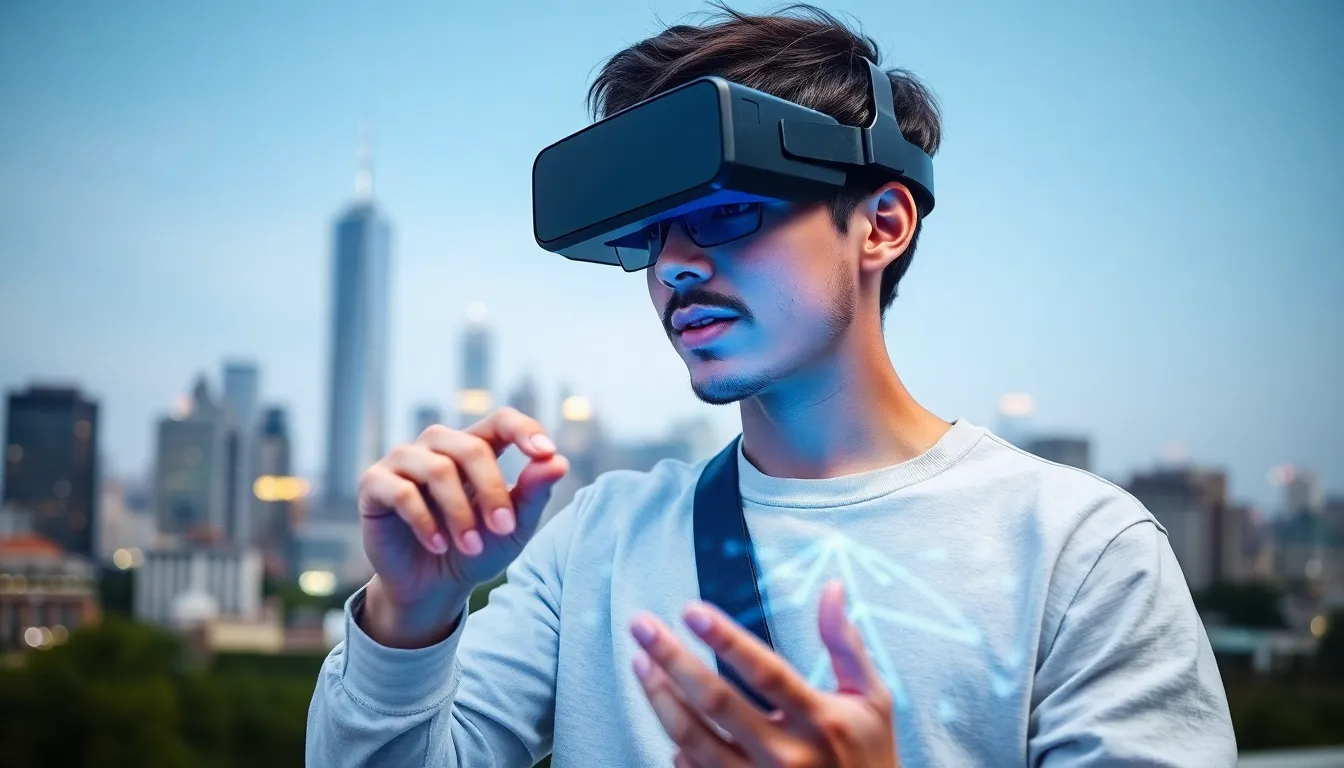Imagine a world where your glasses do more than just help you see; they transform your reality. Augmented reality glasses are here to make that dream a reality, blending the digital and physical worlds in ways that’ll leave you wondering how you ever lived without them. Whether it’s navigating a new city or playing games that leap off the screen, these high-tech spectacles are the ultimate game-changer.
But don’t worry, they won’t turn you into a cyborg—unless you want them to. With sleek designs and intuitive interfaces, augmented reality glasses offer a glimpse into the future without requiring a PhD in tech. So, get ready to elevate your everyday experiences and impress your friends with your shiny new eyewear. After all, who wouldn’t want to look cool while interacting with holograms?
Table of Contents
ToggleOverview of Augmented Reality Glasses
Augmented reality glasses enhance everyday experiences by seamlessly merging digital information with the physical world. These devices project images, graphics, and other content onto the lenses, providing users with interactive experiences. Practical applications span various sectors, including navigation, education, training, and gaming.
Navigation becomes more intuitive when users access real-time directions overlaid on their field of view. Game enthusiasts enjoy immersive experiences that blend the virtual realm with their physical surroundings. Various industries benefit from training programs where individuals practice skills in simulated environments.
User-friendly designs ensure that individuals of all technical skill levels can operate augmented reality glasses. Many models offer voice commands and simple touch gestures, making interactions straightforward. Stylish options are available, allowing users to maintain their personal fashion while enjoying advanced technology.
Model specifications differ, with some providing high-resolution displays, built-in cameras, and long battery life. On average, current models feature a field of view of 40 to 50 degrees, while top-tier options reach up to 60 degrees, enhancing usability. Prices for augmented reality glasses vary, with budget models starting around $300 and premium devices exceeding $1,500.
Sustainability in design has also gained attention, with manufacturers focusing on recyclable materials and energy-efficient components. Users can enjoy the benefits of augmented reality while minimizing their ecological footprint. Continuous advancements promise even more innovative features, ensuring that augmented reality glasses remain at the forefront of technological evolution.
Key Features of Augmented Reality Glasses

Augmented reality glasses come equipped with various key features that elevate user experiences in both personal and professional environments.
Display Technology
Display technology plays a crucial role in delivering immersive experiences. Most models use high-resolution screens, ensuring vivid colors and sharp images. Some devices employ micro-OLED technology, allowing for more compact designs while enhancing clarity. Field of view varies, typically ranging from 40 to 50 degrees, with top-tier options achieving up to 60 degrees. Users appreciate this wider view as it facilitates greater engagement with digital content overlaid in the physical world.
User Interface
An intuitive user interface enhances the overall usability of augmented reality glasses. Voice commands often serve as a primary control method, providing easy navigation between applications. Gesture recognition also allows users to interact seamlessly with digital elements without needing physical controllers. Touch-sensitive areas on the frames contribute additional interaction options. Enhanced interfaces cater to various skill levels, making technology accessible to everyone, from casual users to tech enthusiasts.
Connectivity Options
Connectivity options provide essential ways to integrate augmented reality glasses into everyday life. Many devices support Bluetooth, enabling connections to smartphones for notifications, GPS data, and more. Wi-Fi capabilities facilitate quick access to online content, while some models include 5G support for real-time data streaming. This versatility ensures that users remain connected, allowing them to utilize augmented reality features fully without limitations. Manufacturers prioritize compatibility with multiple platforms, enhancing flexibility for diverse user needs.
Popular Augmented Reality Glasses Available
Many options in augmented reality glasses cater to various needs and preferences. Here’s a closer look at some of the most popular models currently on the market.
Microsoft HoloLens
Microsoft HoloLens stands out with its advanced features designed for professional use. This device exhibits a field of view of around 50 degrees, providing immersive holographic experiences. Users appreciate its high-resolution displays, which ensure clarity during applications like remote collaboration and training. Integration with Windows applications enhances productivity in enterprise settings. Retail prices usually start around $3,500, reflecting its premium technology.
Google Glass Enterprise Edition
Google Glass Enterprise Edition offers a user-friendly interface tailored for business applications. The device displays real-time information while allowing hands-free operation, making it ideal for industries like manufacturing and logistics. Its lightweight design ensures comfort during prolonged use. The battery lasts up to 8 hours, which supports extended work shifts. Priced near $1,800, this model illustrates the shift towards practicality in augmented reality technology.
Vuzix Blade
Vuzix Blade provides an accessible option with competitive features for both consumers and businesses. This model boasts a stylish design that appeals to fashion-conscious users, showcasing a field of view of approximately 30 degrees. Clarity and brightness make it suitable for augmented reality applications in everyday settings. Vuzix Blade integrates voice control and compatibility with smartphones, enhancing user convenience. With a price point around $999, it represents a solid entry into the augmented reality market.
Applications of Augmented Reality Glasses
Augmented reality glasses serve a wide range of applications across various fields. Their capabilities enhance daily tasks and provide innovative solutions in several industries.
In Education
Augmented reality glasses transform classroom learning experiences. These devices allow students to interact with 3D models during science lessons, making complex concepts tangible. Visual simulations enhance understanding in subjects like mathematics and history by bringing abstract ideas to life. Teachers can use AR to develop engaging materials, ensuring students remain focused and interested. Collaborative projects benefit from shared augmented environments, fostering teamwork and creativity among students.
In Healthcare
Healthcare professionals use augmented reality glasses for improved patient outcomes. Surgeons gain real-time data overlays during operations, facilitating precise procedures and reducing risks. Medical training evolves with AR, allowing students to practice in simulated environments without jeopardizing patient safety. Patient education also benefits; doctors can visually explain diagnoses and treatments, enhancing comprehension. Overall, AR enhances efficiency and effectiveness in diagnosis, treatment planning, and surgical procedures.
In Gaming and Entertainment
In gaming, augmented reality glasses provide immersive experiences that blend the virtual and real worlds. Players interact with digital characters in their environment, increasing engagement and excitement during gameplay. Titles like Pokémon Go demonstrate AR’s potential by encouraging exploration in outdoor settings. Live events and concerts employ augmented reality glasses to enhance audience participation, adding layers of interactivity and personalization. This fusion of entertainment and technology revolutionizes how individuals experience games and performances.
Challenges and Limitations
Augmented reality glasses face several challenges that impact their adoption and effectiveness in daily life.
Privacy Concerns
Concerns about privacy arise with the integration of augmented reality glasses into everyday activities. Users might inadvertently record or capture images of people without their consent, leading to potential legal issues. Data collection also presents risks, as many models require access to personal information and location data for optimal functionality. Security breaches could expose sensitive data, creating distrust among potential users. High-profile incidents involving unauthorized surveillance further exacerbate these concerns. Therefore, manufacturers must prioritize user privacy through robust data protection measures and transparent policies.
Cost and Accessibility
Cost remains a significant barrier to widespread adoption of augmented reality glasses. Prices for premium models, such as the Microsoft HoloLens at around $3,500, limit accessibility for average consumers. Budget models exist, yet they may lack essential features, discouraging use among budget-conscious users. Additionally, the technology’s advanced capabilities often cater to specific industries, like healthcare or education, which can alienate general consumers. Strategies like subsidies for educational institutions or healthcare organizations could foster broader access. Moreover, as manufacturing scales up and competition increases, prices are expected to decrease, potentially improving accessibility over time.
Augmented reality glasses represent a significant leap in technology that reshapes how individuals interact with their surroundings. With applications spanning education, healthcare, and entertainment, these devices enhance daily experiences while offering a stylish accessory for users. As advancements continue to emerge, the potential for even more innovative features becomes increasingly promising.
While challenges like privacy concerns and cost remain, solutions are being explored to make these devices more accessible. The future of augmented reality glasses looks bright as they pave the way for a new era of interaction between the digital and physical worlds. Embracing this technology not only enhances functionality but also enriches the user experience in countless ways.






